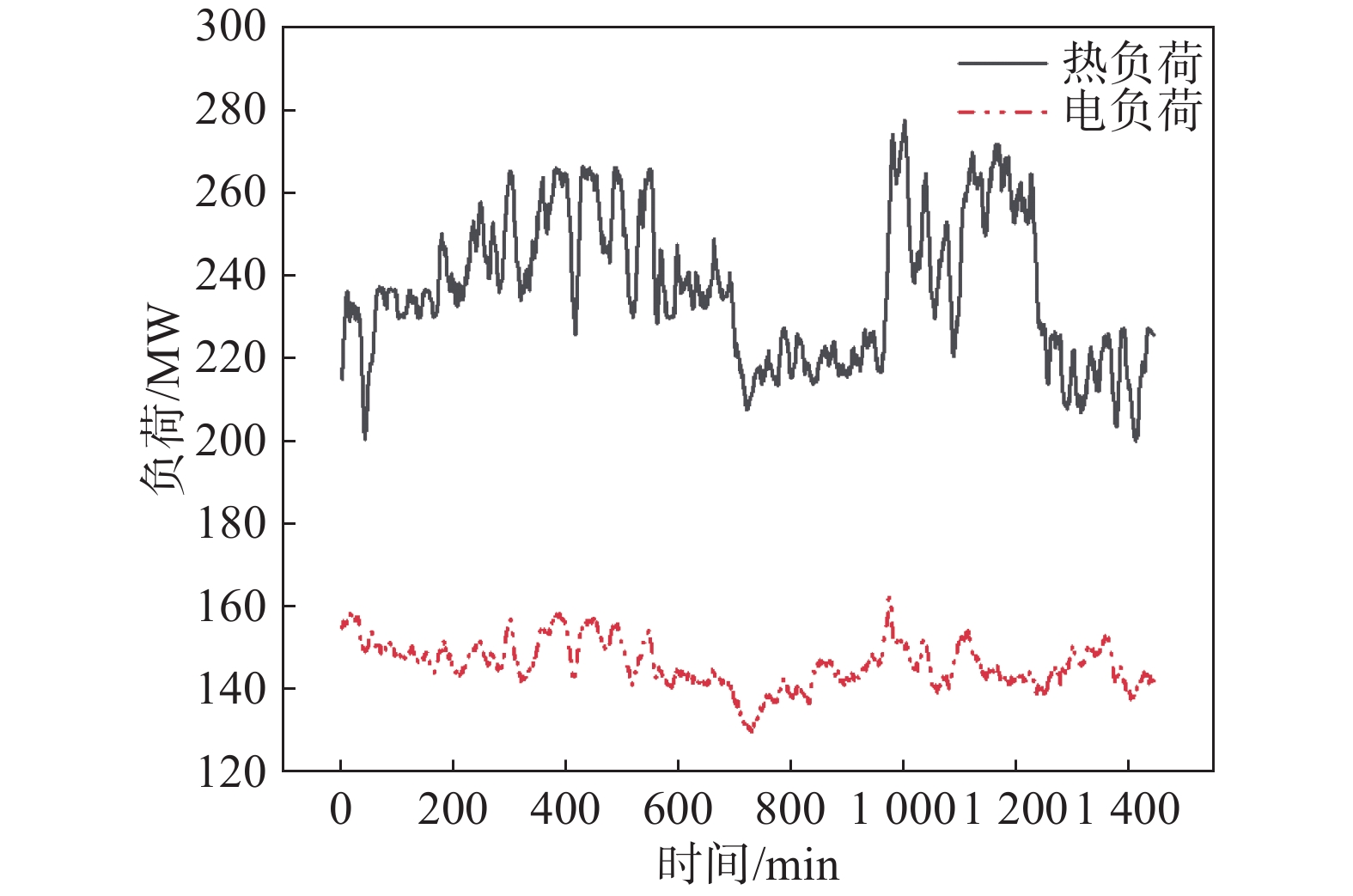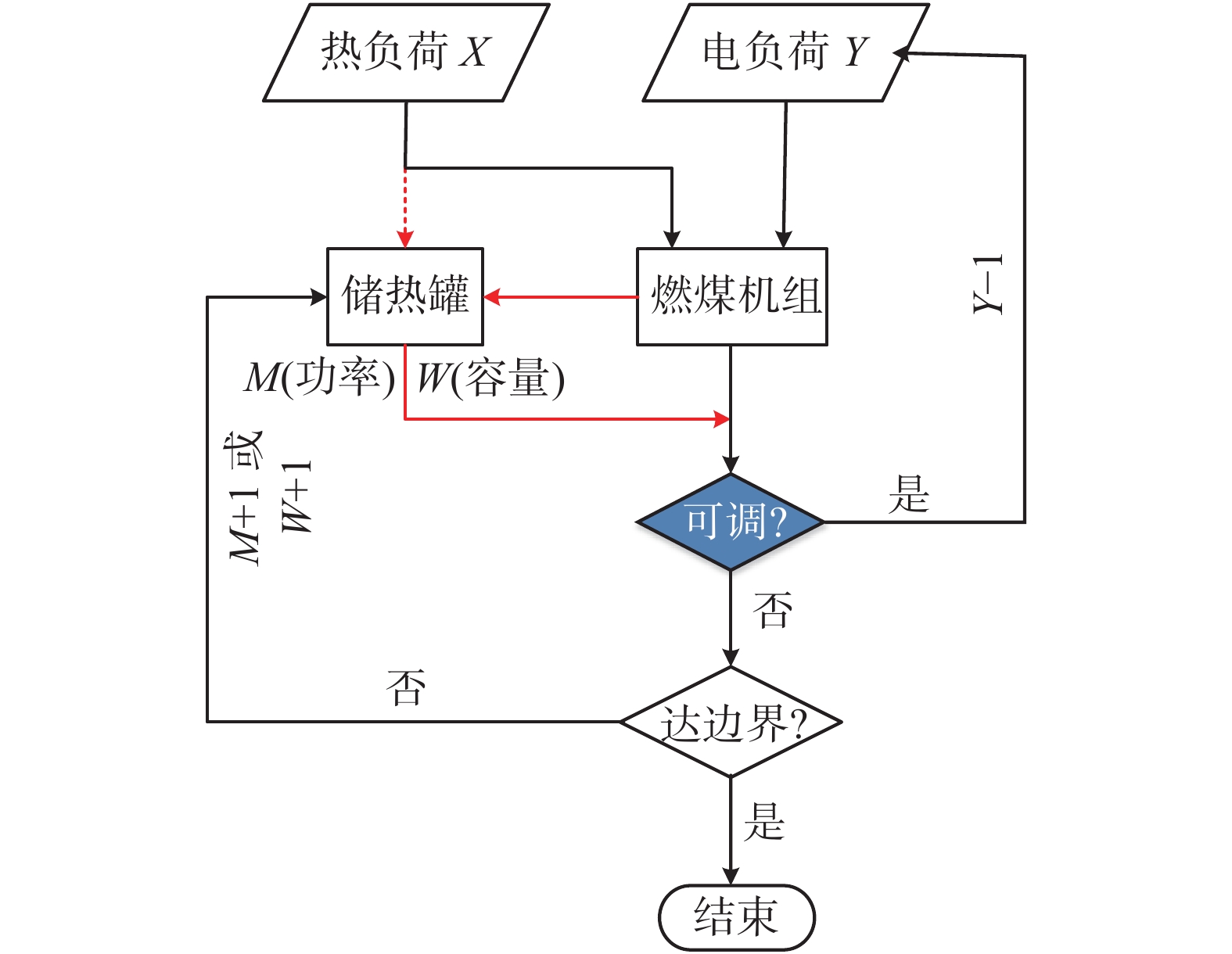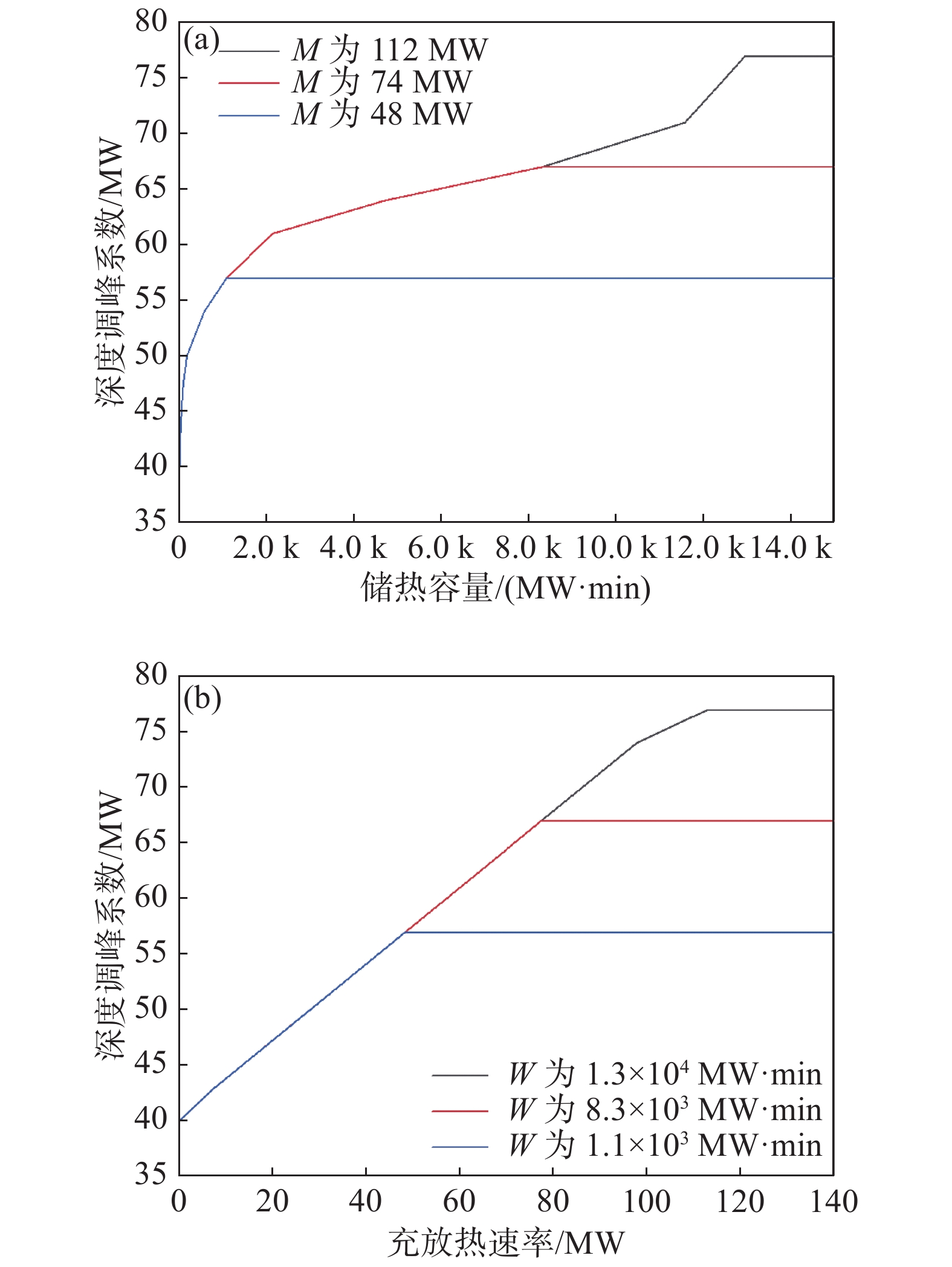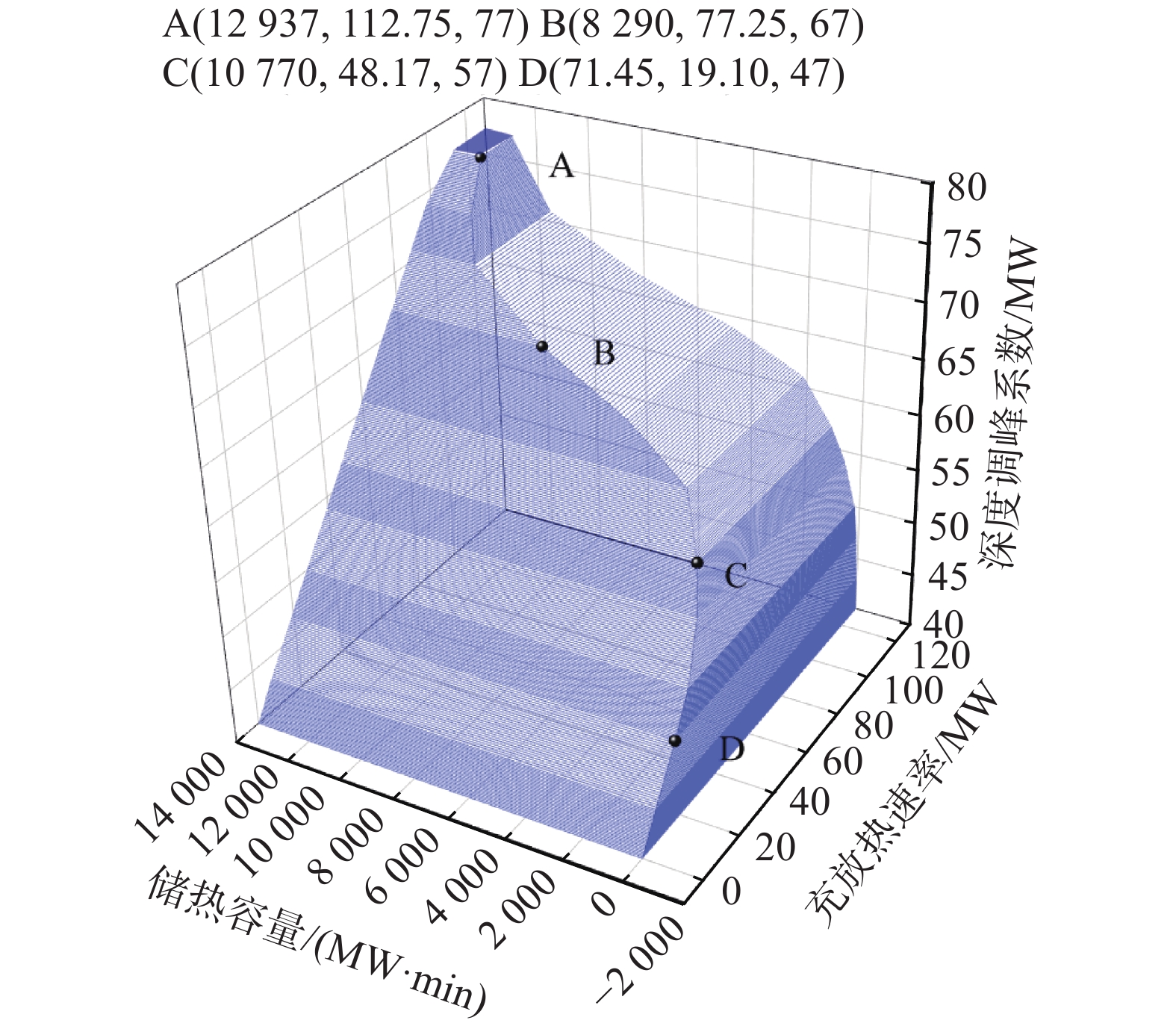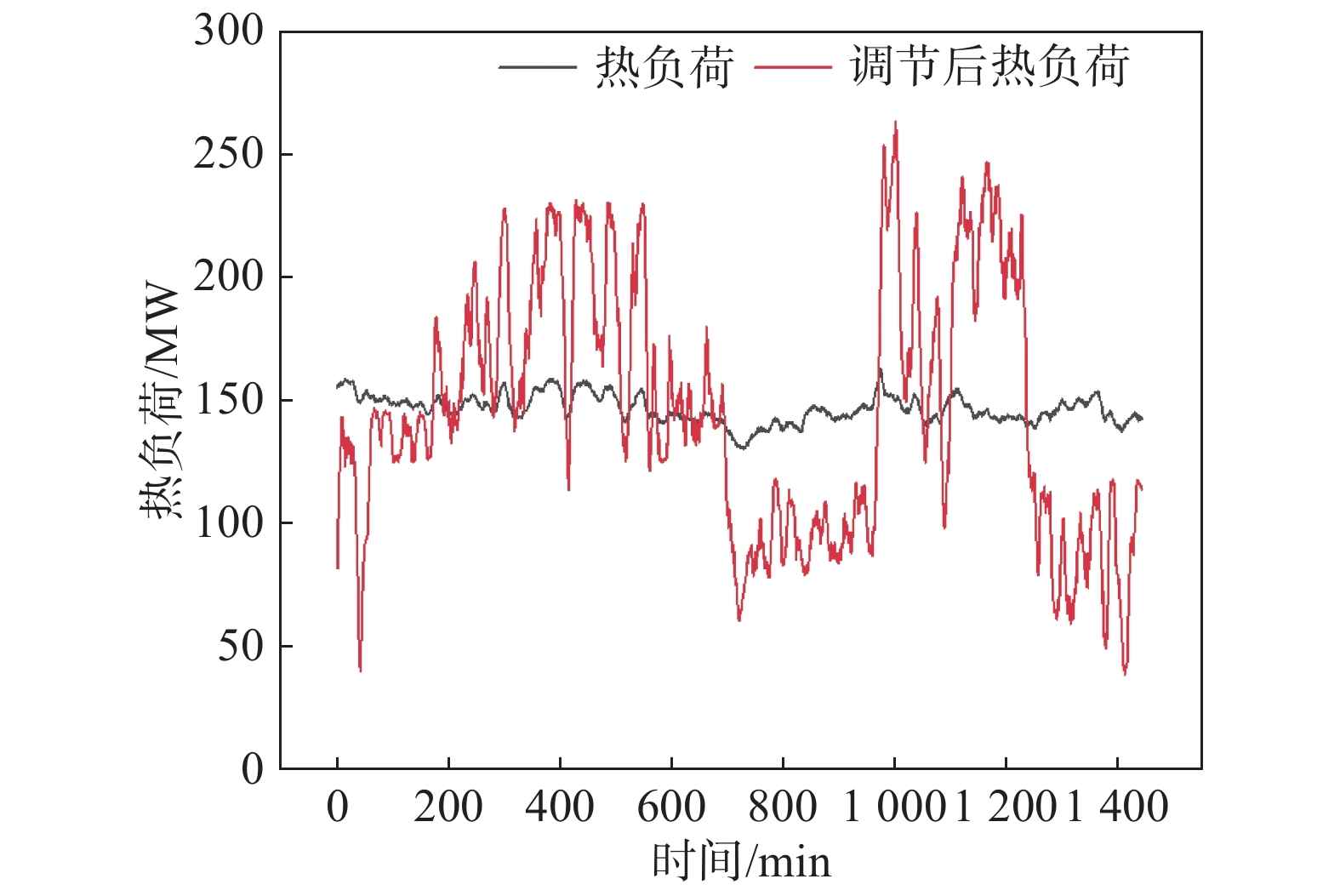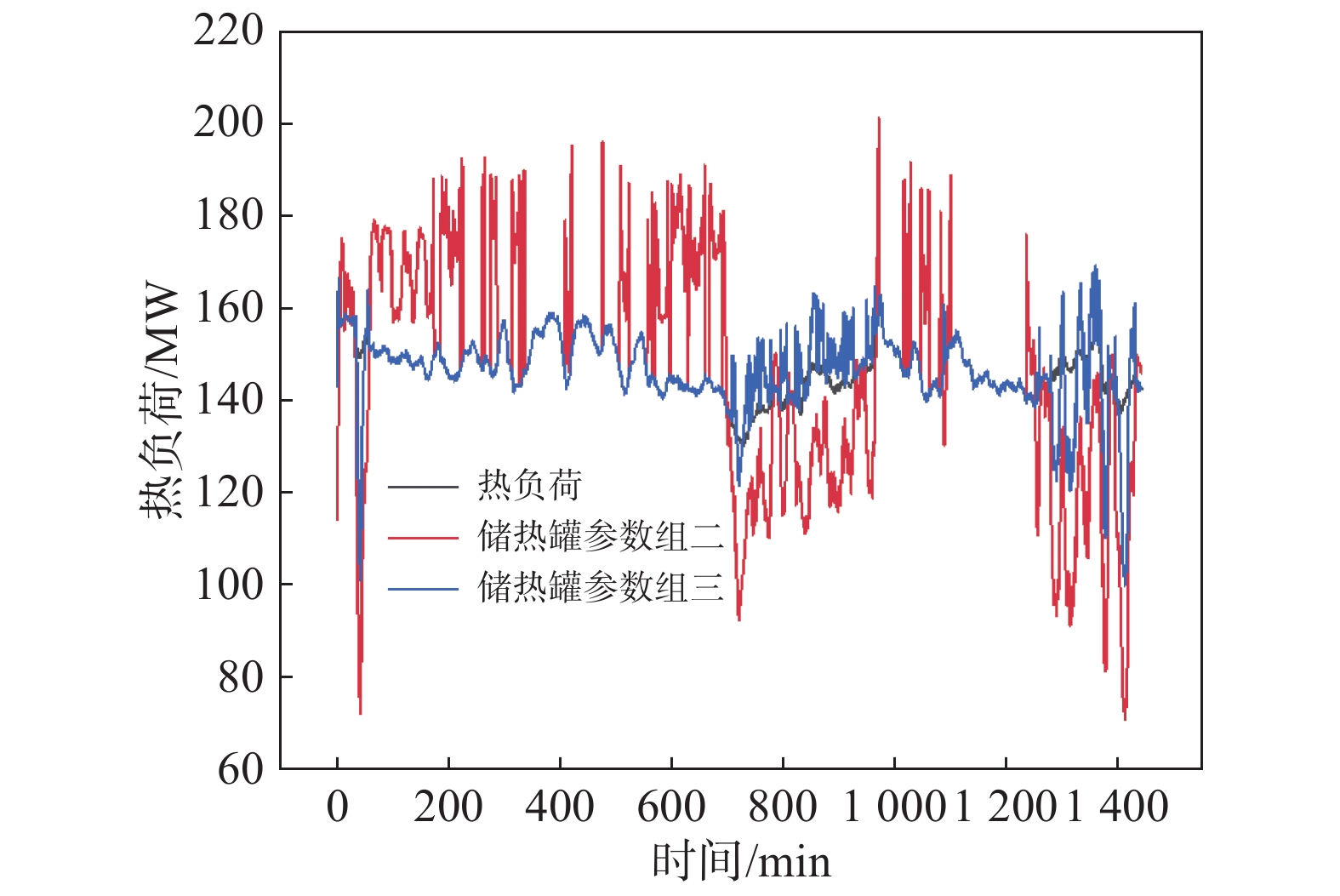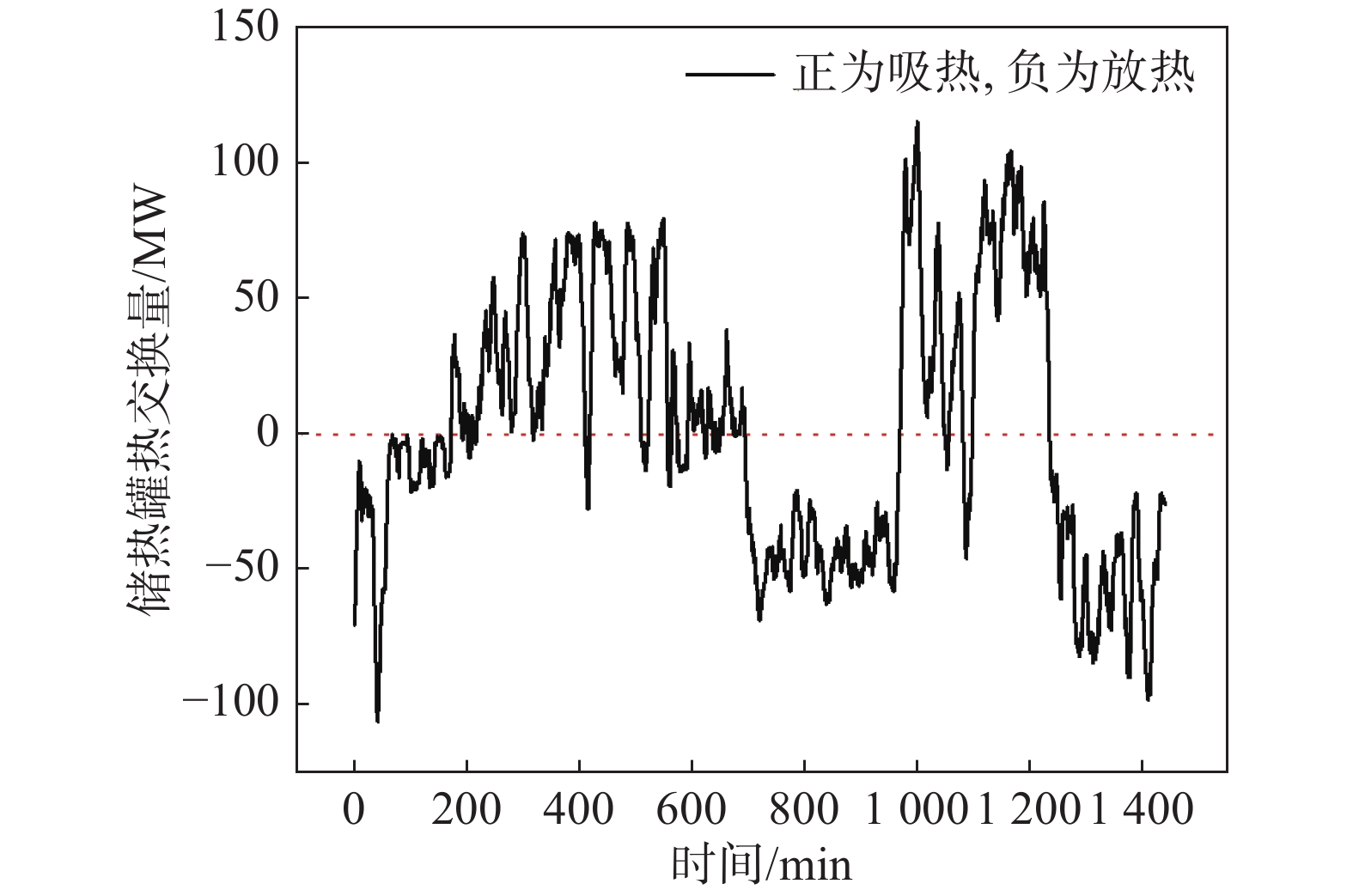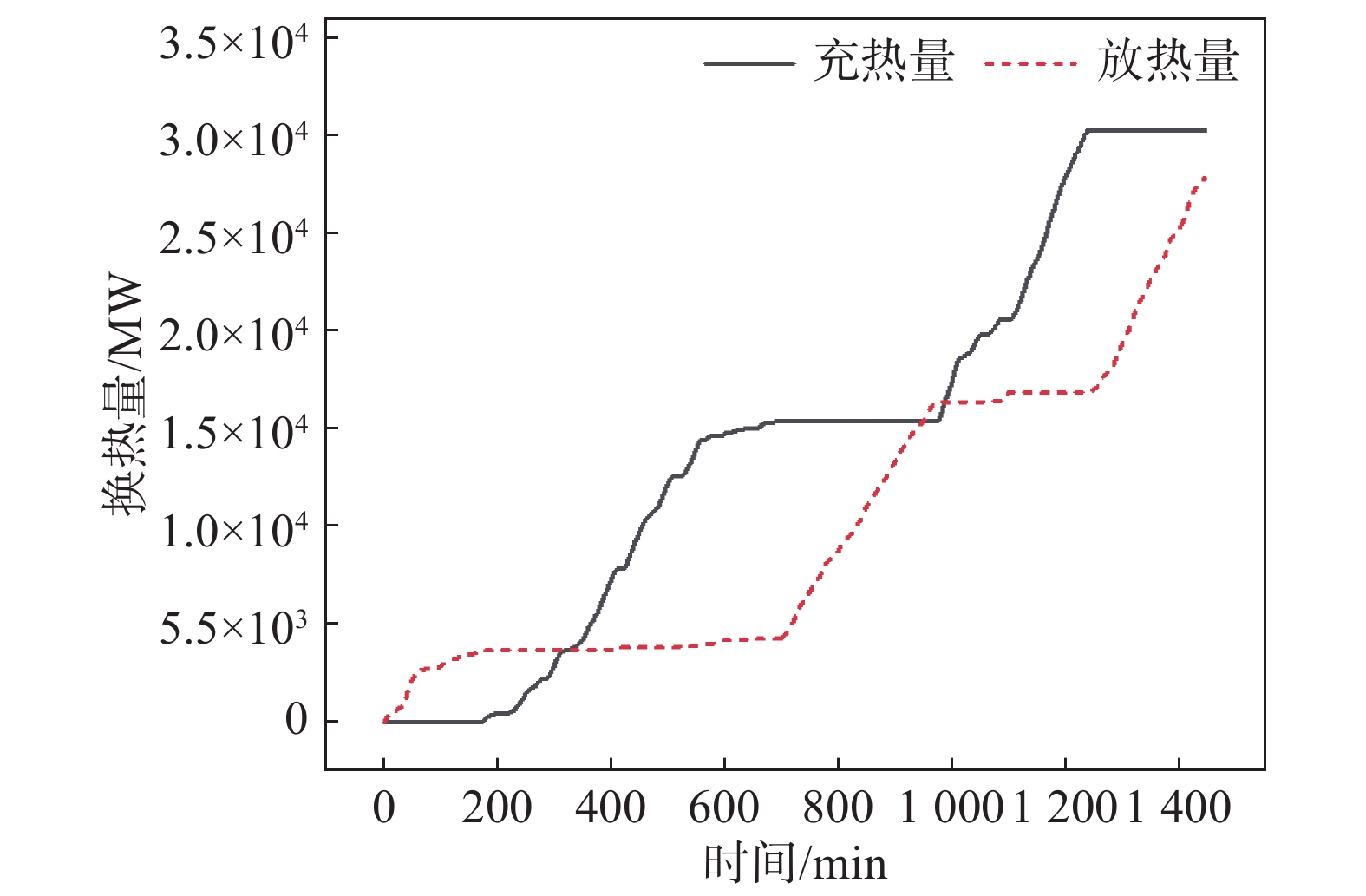-
中国能源电力行业仍以煤炭为主。煤粉的大量燃烧对中国生态环境保护造成了巨大压力[1]。朱明亮[2]预测,在高GDP增长率下,2030年能源需求将达到约45亿t标准煤,他通过对能源现状、消费等因素统筹分析,认为走清洁发展的道路是实现可持续发展的关键。随着经济生产的发展以及“双碳”政策的有序推进,中国能源电力结构的清洁化转型进程将呈现递进式发展趋势,目前主要是在技术进步等多方面推进清洁能源的稳定发展[3-4]。清洁能源在时空上的不稳定性使电力系统运行的稳定性受到冲击。与此同时,燃煤发电机组承担了调峰调频重要任务,其在能源转型中的作用已发生了改变[5-6]。对热电联产机组进行灵活性改造,提升机组深度调峰能力,是解决电力系统不稳定问题的关键[7]。王金星[8]以大型热电联产机组为依托,提出了提高系统灵活性的必要性,着重研究了运行效率对机组灵活性的影响,并阐述了扩大热电比、增设电热转换装置以及耦合储能系统等方法来提高机组调节灵活性可行性与工程价值。此外,机组自身的运行策略对增加燃煤热电联产机组的调峰潜力和节能减排有着重要意义。同时,由于供热机组所涉及到的参数众多,工况复杂且差异较大,在机组运行中对供热机组进行策略优化具有重大意义[9-10]。印佳敏等[11]就储能设备与机组联合调频方面展开仿真模拟,分析储能相关参数与机组调频能力之间的关系,结果表明通过仿真模拟对相关参数进行设计研究与优化是可行的,为该方向研究推进指明了道路。此外,热电联产具有很强的耦合性,使得系统满足热电负荷需求能力受到了影响[12],因而对热电联产机组进行改造使其实现热电解耦是提高其灵活性的重要措施。Liu等[13]通过对一台350 MW的机组进行分析,得出蓄热箱解耦技术是较好的方案。李峻等[14]为了提高机组的灵活性,提出了使用熔融盐储热罐储热设备与机组进行耦合的办法并对此展开研究,结果表明该措施显著提高了机组的深度调峰能力,实现了机组的灵活运行。王金星等[15]为提高机组的灵活性,选择中间抽汽、电热泵、电锅炉与抽汽联合等改造方法来实现热电解耦,通过仿真模拟和案例分析,得到电热泵对机组灵活性提高起显著作用的结论。此外,王金星[16]还详细评述了当下单一储热装置、电热转换–储热装置等储能设备参与燃煤机组调峰调频的现状,同时强调了单一储热装置与机组耦合的改造方式在工程中应用的广泛性与可行性。张翼等[17]以350 MW机组为案例分别对增设储热罐、增设蓄热电锅炉等方案相较于原供热方案在消纳风电容量、扩大热电比例等参数方面的提升情况展开了研究,结果表明耦合储热罐储热装置对相关指标的提升有显著效果,因此热电解耦技术在燃煤热电联产机组的灵活性发展中具有重要地位。综上所述,为了以较低成本来实现热解耦从而提高机组调节的灵活性,增设耦合储热装置的措施具有较为广阔的前景。
本文针对热电联产机组的热电解耦方面提出了耦合储热系统辅助调峰的措施,并以此为基础对储热装置的储热容量以及充放热速率对机组调节效果的影响展开了研究,希望对现有机组的相关参数进行优化提供参考。
-
本工作研究对象为储热装置(热水储罐)与火电厂耦合装置,其基本原理为利用中压缸部分蒸汽为储热罐提供高品质热量,然后由储热罐储存并以热交换的形式传递给水,增加汽轮机机组蒸汽量,提高效率。储热罐耦合机组的具体流程如图1所示,由中压缸中抽取部分的高温过热蒸汽,通过储热罐将部分热量以热交换的方式储存在储热介质中,之后放热后的乏汽经过除氧器除氧后重新返回主系统参与循环,完成储热过程;储热达到要求时,由凝结水泵支路引入给水,储热罐中的储热介质将热量传递给低温给水,使其升温到系统要求温度,再经过除氧器除氧后进入系统,完成释热过程。
-
本文的研究目的是在使用储热罐与热电联产机组相耦合工作时,在系统可调的条件下,利用储热罐的储热能力,解除热电负荷之间的强耦合关系。首先通过数据采集得到供暖季电热负荷曲线,如图2所示,并根据前期Ebislon软件模拟得到热负荷与其对应电负荷的上下限的关系,得到电负荷的可调范围[17]。
储热罐与热电联产燃煤机组相耦合工作的计算逻辑如图3所示,即计算储热罐发挥最大储热能力时系统可达到的最大热电负荷比。其中X为供暖季热负荷波动曲线,Y为电负荷波动曲线,M和W分别为储热罐的吸放热效率和容量。二者均以0为初始值参与计算,最终达到储热罐的储热能力上边界。
其中判定过程包括“可调”和“达边界”两个约束。判断“可调”的依据为储热罐在充放热效率和容量共同决定的储热能力下调节热负荷,在调整后的热负荷下,机组承担该时刻相应的电负荷,可正常运行。若“可调”,则进入储热罐是否“达边界”判断,否则提高电负荷。判断“达边界”的依据为本次循环中储热罐的效率与容量可以达到人为规定的储热罐储存热量的上边界。若不能“达边界”,则增加储热罐的效率与容量。
根据区域热负荷需求,可进行燃煤机组的电负荷调节上限和下限的判断:当满足燃煤机组调节下限时,将各个时间点的电负荷进行调峰,直至燃煤机组不可调;当燃煤机组不可调时,通过储热罐满足部分热负荷需求,实现部分热电解耦后,燃煤机组侧又重新达到了满足调节的条件。需要指出的是,初始的热负荷X和电负荷Y均来自区域的实际热电需求。储热罐初始参数设定吸放热速率M和储热容量W均为0,根据实际调节需求,逐次增加M和W的数值。为确保机组各组件正常工作,调峰深度应在合理范围,最后边界设定为Y的最小数值为350 MW功率的30%,即最小电负荷降到105 MW时终止。
本计算逻辑的合理性在于是基于优先满足储热罐与燃煤机组耦合系统可调节能力的前提来实现热电负荷比最大,且在计算过程中综合考虑了储热罐的充放热平衡,与工程实际联系紧密。
-
在储热容量与深度调峰能力的关系的计算中,不限定储热罐与机组之间的充放热速率,可与储热容量进行最佳匹配,因此储热容量在某一时刻可释放全部热量来对电负荷进行调峰。就实际热电负荷曲线通过计算逻辑进行计算,得到结果如图4所示。其中图4(a)为控制充放热速率按照等梯度递增计算储热容量与深度调峰之间的关系,图4(b)则为控制储热容量梯度增加来得到充放热速率与深度调峰之间的关系。
由图4(a)可知,随着储热容量的增加,调峰能力呈现先上升后平缓的趋势,并且随着充放热速率的梯度增加,可达到的最大深度调峰能力逐渐上升;而当充放热速率大于112 MW时,再提升储热容量,最大深度调峰能力将不再发生变化,此处认为储热罐提升深度调峰能力达到上限。主要原因是随着储热罐储热容量的增加,可保证释放的热量逐渐增加,深度调峰能力也随之增加;而当储热容量增加到一定量时,储热罐充放热量将达到平衡,使得调节能力达到上限;此外,当储热容量足够时,充放热速率也会对深度调峰能力的提升起限制作用,当储热容量在与充放热速率相匹配时,其深度调峰能力将不再发生变化。充放热速率对深度调峰的影响则如图4(b)所示,储热罐的容量在每组计算中不变且在各组计算递增。当需要对电负荷进行调节时,只有充放热速率对其有所影响。需要说明的是,这里的充放热速率所代表的是1 min内的平均速率。由图4可以看出,充放热速率与储热容量对深度调峰的影响效果类似,即均呈现先上升后平缓的趋势,且当充放热速率为112 MW时取得最大值。主要原因与储热容量类似,即当充放热速率达到112 MW时,在该时刻储热系统所能释放的热量达到机组调峰的顶点,当再对其进行提升,在合理的储热容量配合下,机组深度调峰能力将基本不会发生变化。
综上所述,深度调峰能力不仅与储热罐的性能参数有关还与其参数之间的匹配性有紧密联系。
-
储热参数匹配性对深度调峰能力的影响不可忽视。在对储热参数匹配性进行研究时,首先应考虑二者对深度调峰能力的独立影响及之间的相互作用。计算得到储热参数与深度调峰的关系如图5所示。为便于案例计算,本文将图5曲面上任意点所涉及的储热容量与充放热速率两参数称为一个参数组,设定了参数组一(A点)、参数组二(B点)、参数组三(C点)以及参数组四(D点)。
可以看出,当单位时间内的充放热速率与储热容量相匹配时,二者调节效果最佳且机组运行最经济,不会抑制其中某一参数发挥作用;当只观察某一参数时,在该参数未达到临界点时,两参数匹配时,可取得局部最大值;图像最大值出现在储热容量为129 37 MW·min且充放热速率为112.75 MW时。
-
由3.2中结果可知,当使用案例中的实际热负荷与电负荷的平均值计算时,储热罐的储热容量达到129 37 MW·min且充放热速率达到112.75 MW时,深度调峰以及热负荷的调节效果最好,即当储热罐的储热容量与充放热速率相匹配时,调节效果最好。因而本小节首先在该参数下对储热罐在1 440 min内对热负荷的实际调节能力展开计算,得到热负荷波动调节结果如图6所示。可以看出,在该参数下,储热罐储热装置分担热负荷以及调节热负荷的能力显著,可有效提高系统电负荷的跟随能力。
为进一步验证分析储热参数对热负荷调节能力的影响规律,针对图5所显示的针对不同梯度的参数,代入模型展开计算。以B点与C点为例,两点的充放热速率与储热容量均处于匹配状态。得到计算结果如图7所示,各组储热参数对热负荷的调节都有明显效果,且随着参数的提升,热负荷调节效果逐渐提升。结合图6进一步验证可得:储热罐充放热速率达到平衡时的参数所对应的调节能力最强。
综上所述,储热罐的放热对于机组的调节效果显著,可有效对电负荷进行调峰从而增加新能源电力的消纳比例,并且还可调节热负荷。而对于储热罐总体而言,由于在放热的同时进行充热,大大降低了储热罐储热容量需求,因而还需对其充热过程、充热量及其时间分配展开研究。
对案例中1 440 min内的电热负荷展开计算,得到结果如图8与图9所示。充热热量与吸热热量积分曲线均呈上升趋势,在该时间段末期,充热的热量略大于吸热热量;在该条件下,当电负荷整体下调一个数值,实现深度调峰时,储热罐的充热与放热可达到基本平衡状态,即储热罐在该时间内充热量略大于放热量,既保证了储热罐的正常工作与电负荷调峰效果又大大降低了对储热罐的储热容量要求。
由以上结果可以看出,通过储热系统与热电联产机组的耦合,实现了对电负荷的深度调峰和热电解耦,提高了机组调节的灵活性,进而可以提高对新能源电力的消纳能力和燃煤机组自身的效率,实现节能减排的效果。以图8所示电负荷调峰结果为案例可算出在储热罐与燃煤机组耦合时,根据在该模型中计算热负荷以及热负荷所折合的电负荷相关公式,可得每天节省燃煤量约809 t,即降低了约20.91g/kWh。根据马大卫等[18]的研究并实地调研安徽煤电厂的生产情况,得出煤耗与硫氮污染物及颗粒物之间的关系如表1所示。由于本文案例为350 MW机组,将煤耗与污染物之间的关系近似为线性,可知在本案例中,由于使用储热装置对热电联产机组进行耦合,可大约减少二氧化硫0.023 g/kWh,氮氧化物0.045 5 g/kWh以及颗粒物0.011 g/kWh。
机组 煤耗/
[g·(kWh)−1]SO2/
[g·(kWh)−1]NOx/
[g·(kWh)−1]颗粒物/
[g·(kWh)−1]350 MW 311.61~329.994 0.04~0.06 0.10~0.14 0.01~0.02 Table 1. Relationship between coal consumption and pollutants of coal-fired units
-
本文以某350 MW火电机组为研究对象,对其耦合储热罐参数进行了系统分析,重点分析了储热容量和充放热速率的影响,并结合实例分析了储热罐充热和放热积分情况。具体结论如下:
1)在储热罐与火电厂耦合工作时,随着储热容量或充放热速率参数的升高,深度调峰能力逐渐提高;在两参数分别达到129 37 MW·min与112.75 MW时达到深度调峰能力上限约77 MW后趋于平稳。此外,两参数对其深度调峰能力共同影响,参数间的匹配可使约束达到平衡。
2)案例分析显示,储热设备与机组耦合实现一定程度热电解耦后储热罐热交换量的变化,储热罐在完成1 440 min的吸放热过程后,可知其净吸热约2 400 MW·min,该边界情景下储热装置可正常运行,因而可知耦合储热系统调峰的可行性。
3)供暖季的节煤量为20.91 g/kWh,相应地,可减少污染物排放。其中具体种类下降数值为:二氧化硫0.023 g/kWh、氮氧化物0.045 5 g/kWh以及颗粒物0.011 g/kWh。
Parameter Design of Heat Storage for Auxiliary Peak Regulation System in Thermal Power Unit
doi: 10.16516/j.gedi.issn2095-8676.2022.03.002
- Received Date: 2022-03-14
- Accepted Date: 2022-04-11
- Rev Recd Date: 2022-04-11
- Available Online: 2022-07-06
- Publish Date: 2022-09-25
-
Key words:
- heat storage system /
- steam condensing unit /
- thermoelectric decoupling /
- steam heating /
- parameter optimization
Abstract:
| Citation: | SUN Haocheng, SONG Minhang, GUO Puwei, ZHANG Changyong, WANG Jinxing. Parameter Design of Heat Storage for Auxiliary Peak Regulation System in Thermal Power Unit[J]. SOUTHERN ENERGY CONSTRUCTION, 2022, 9(3): 9-15. doi: 10.16516/j.gedi.issn2095-8676.2022.03.002 |


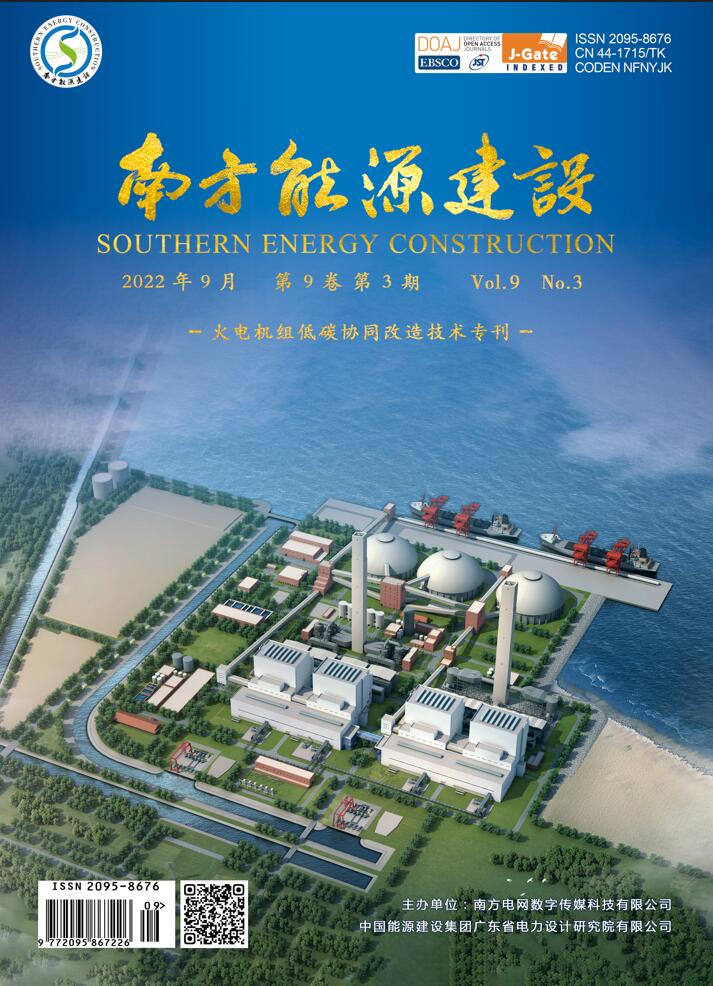

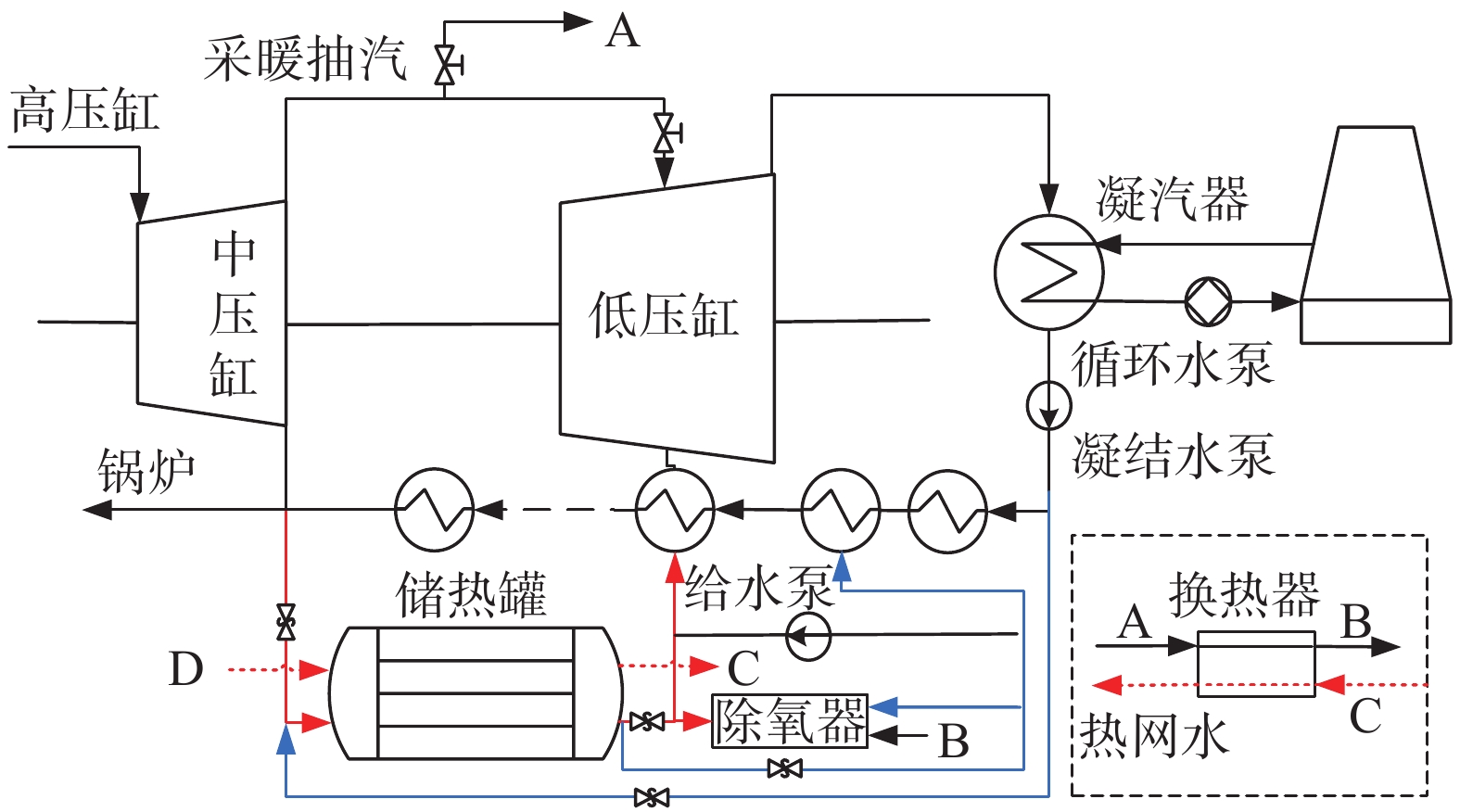

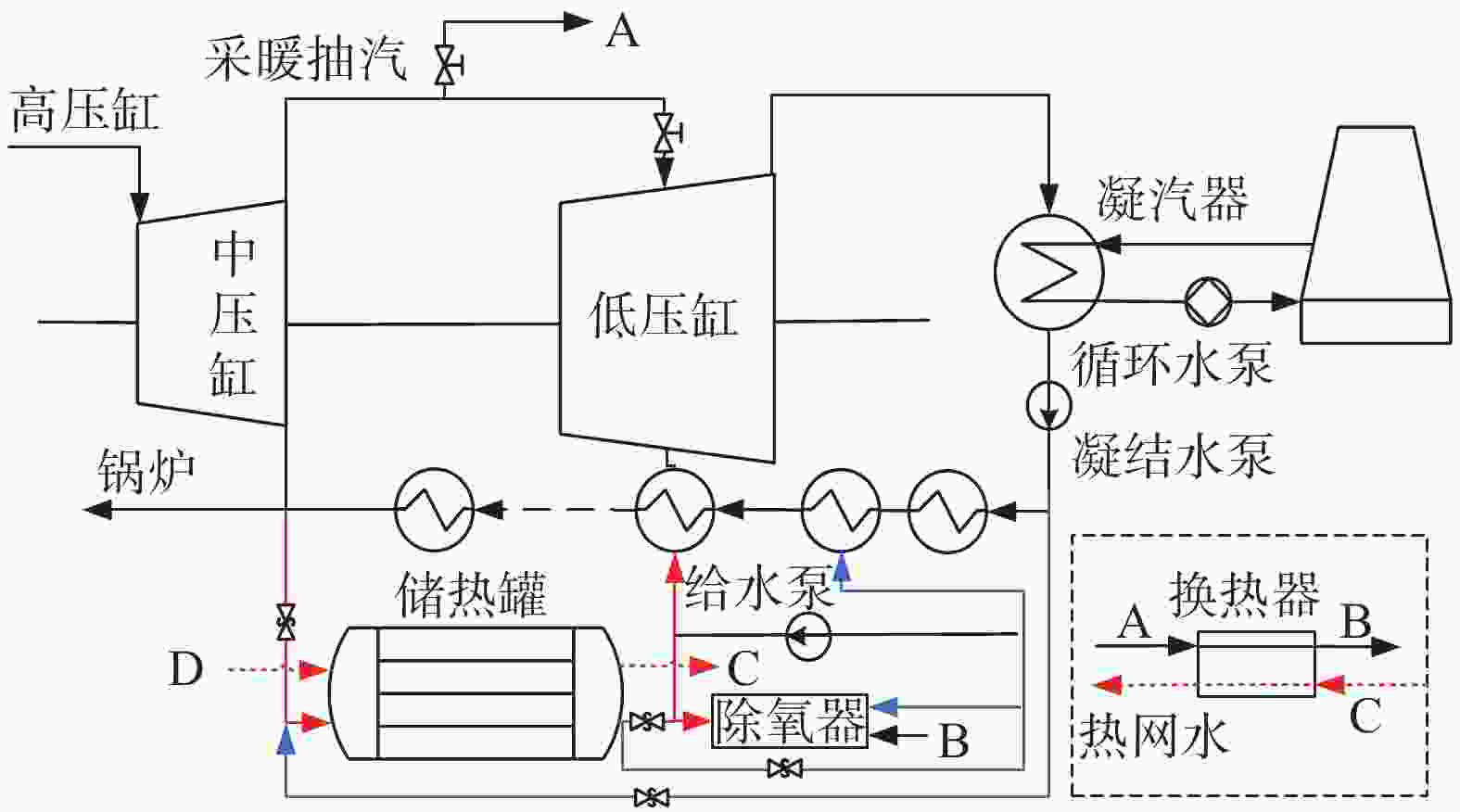
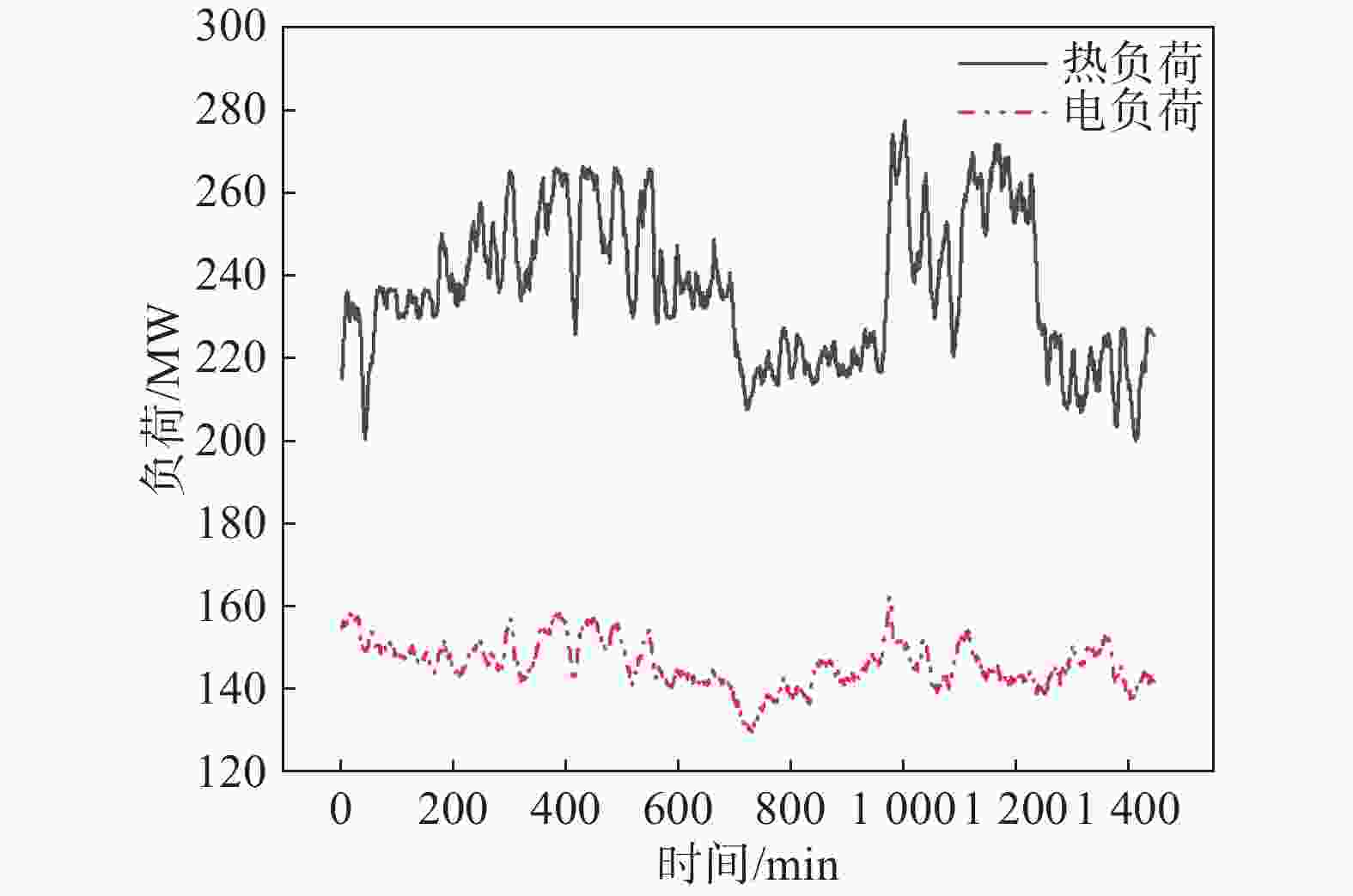
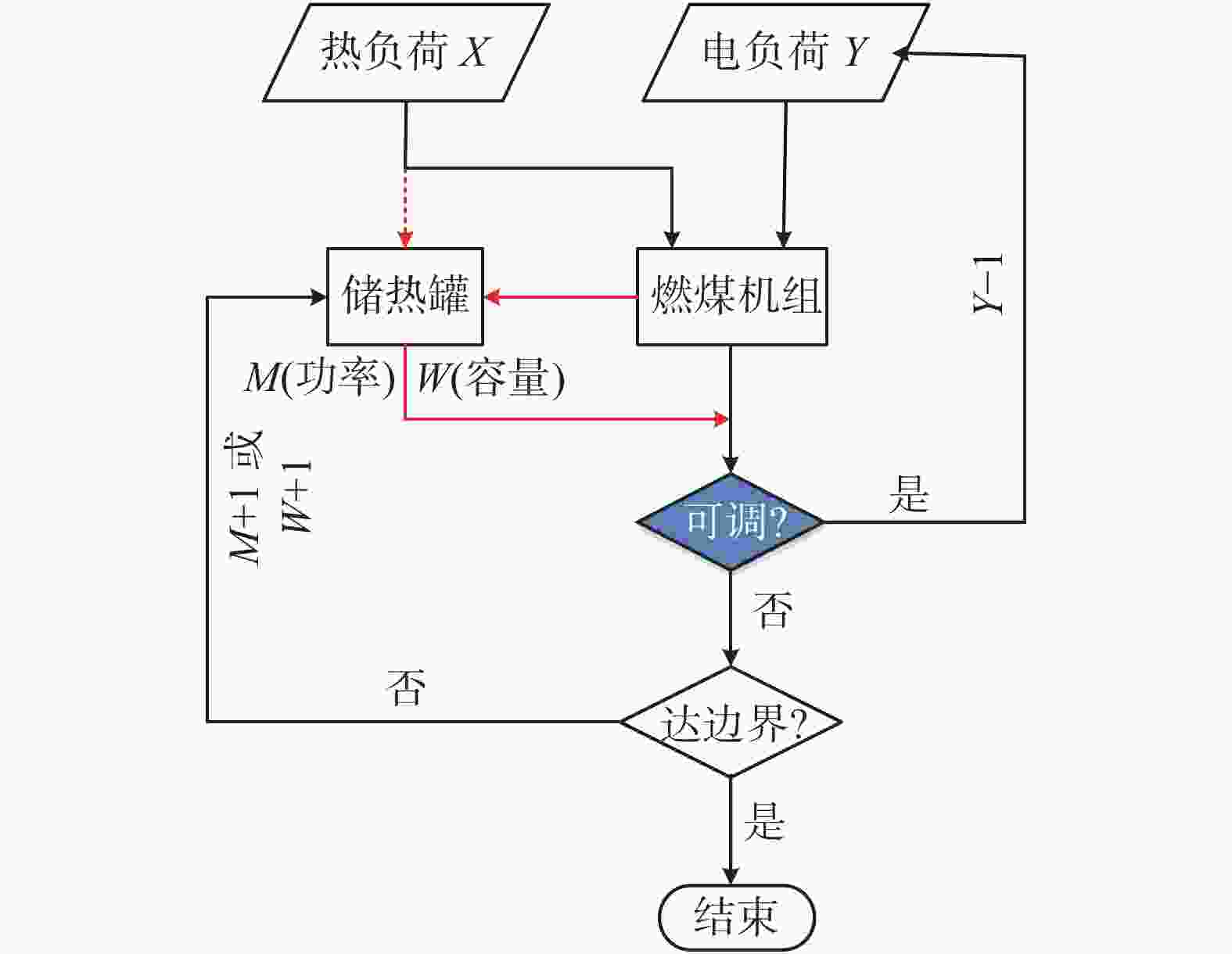
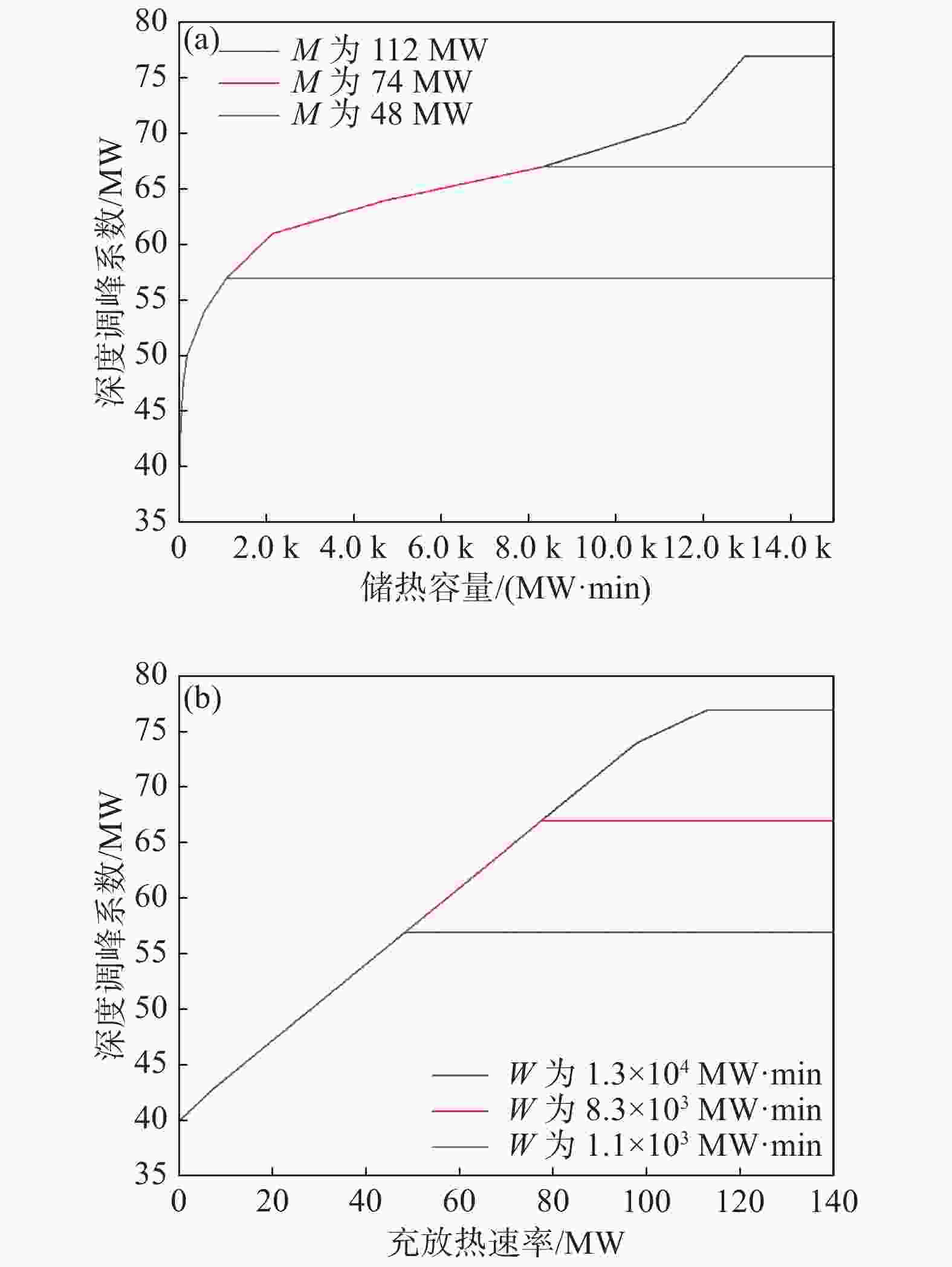
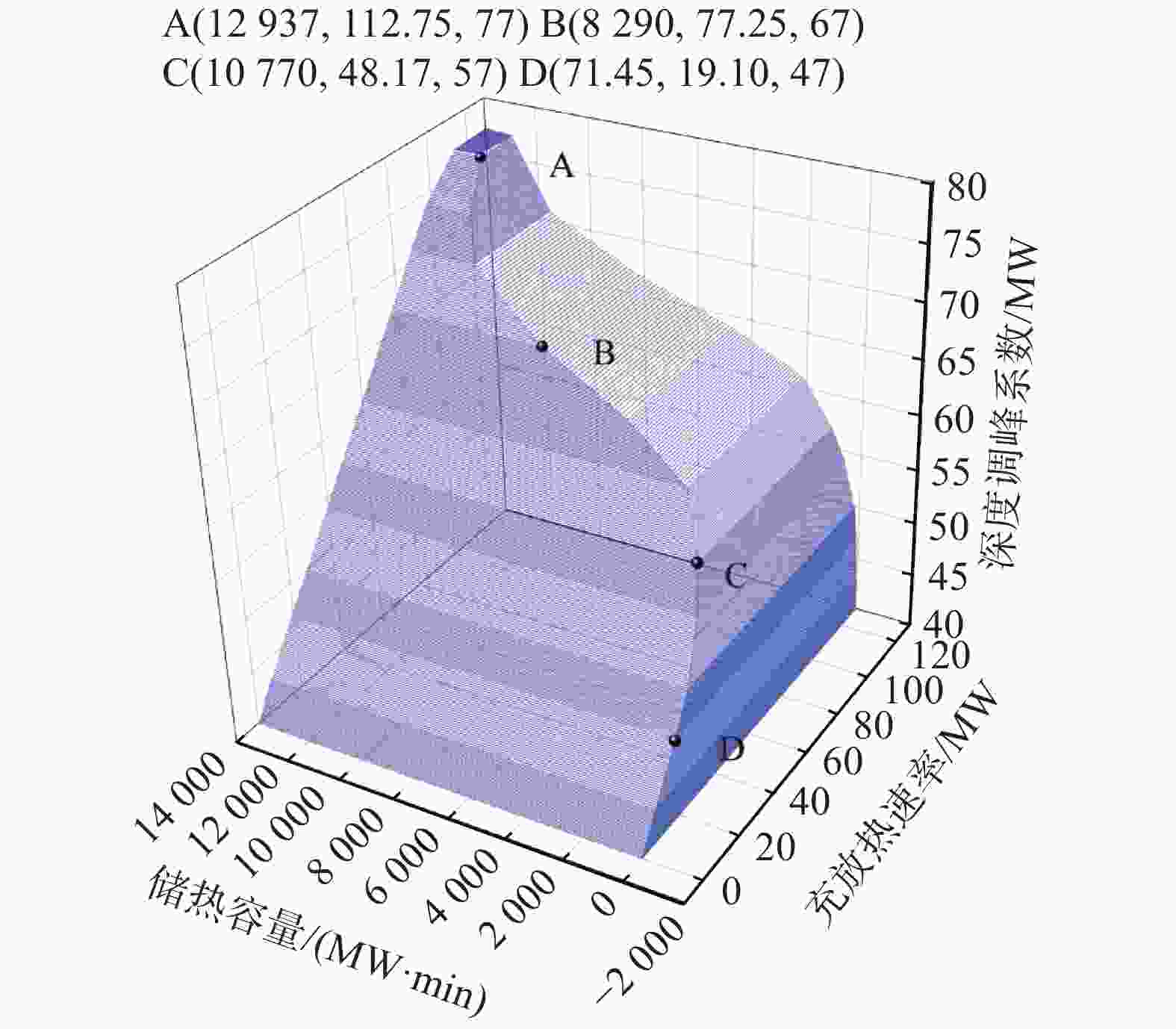
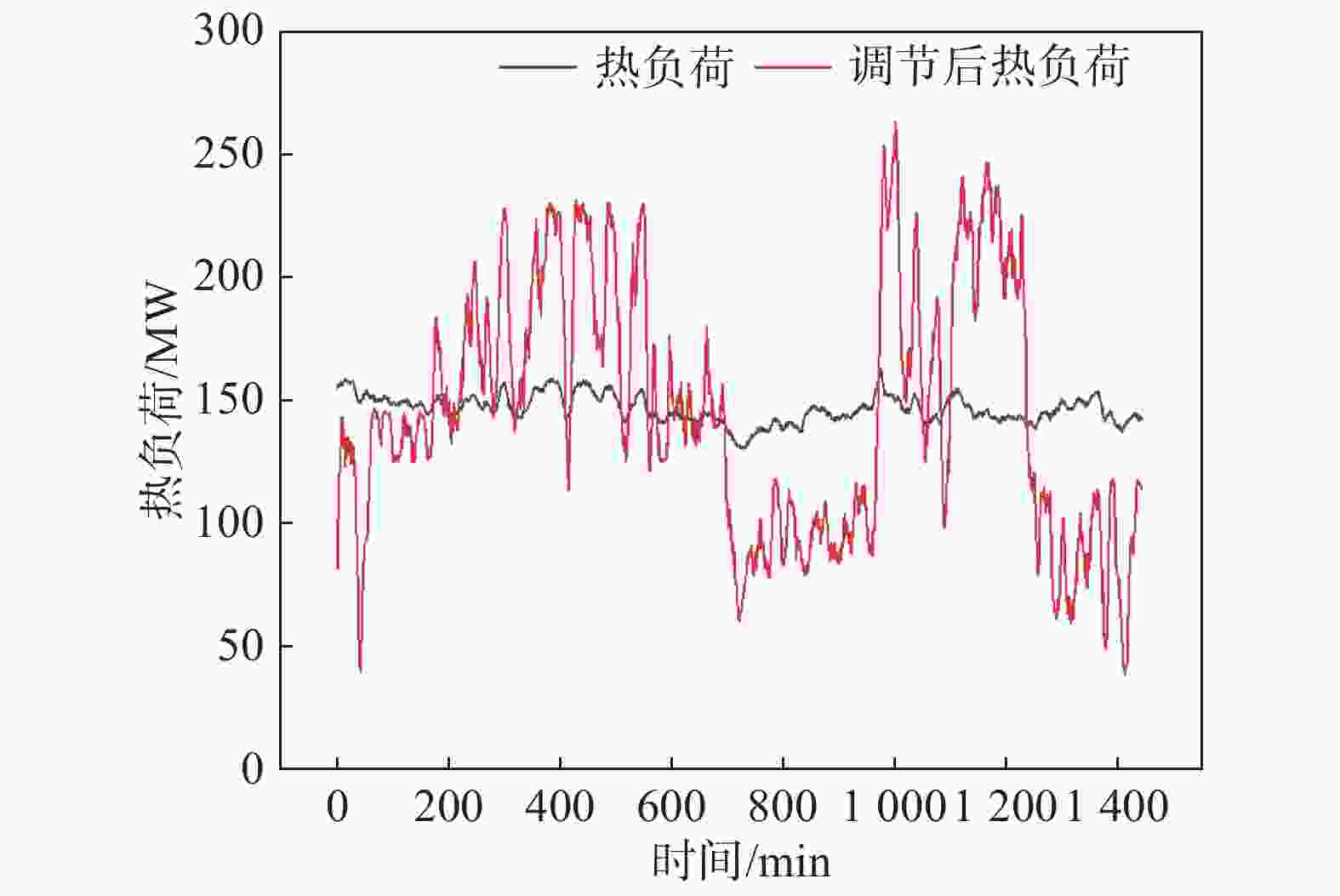
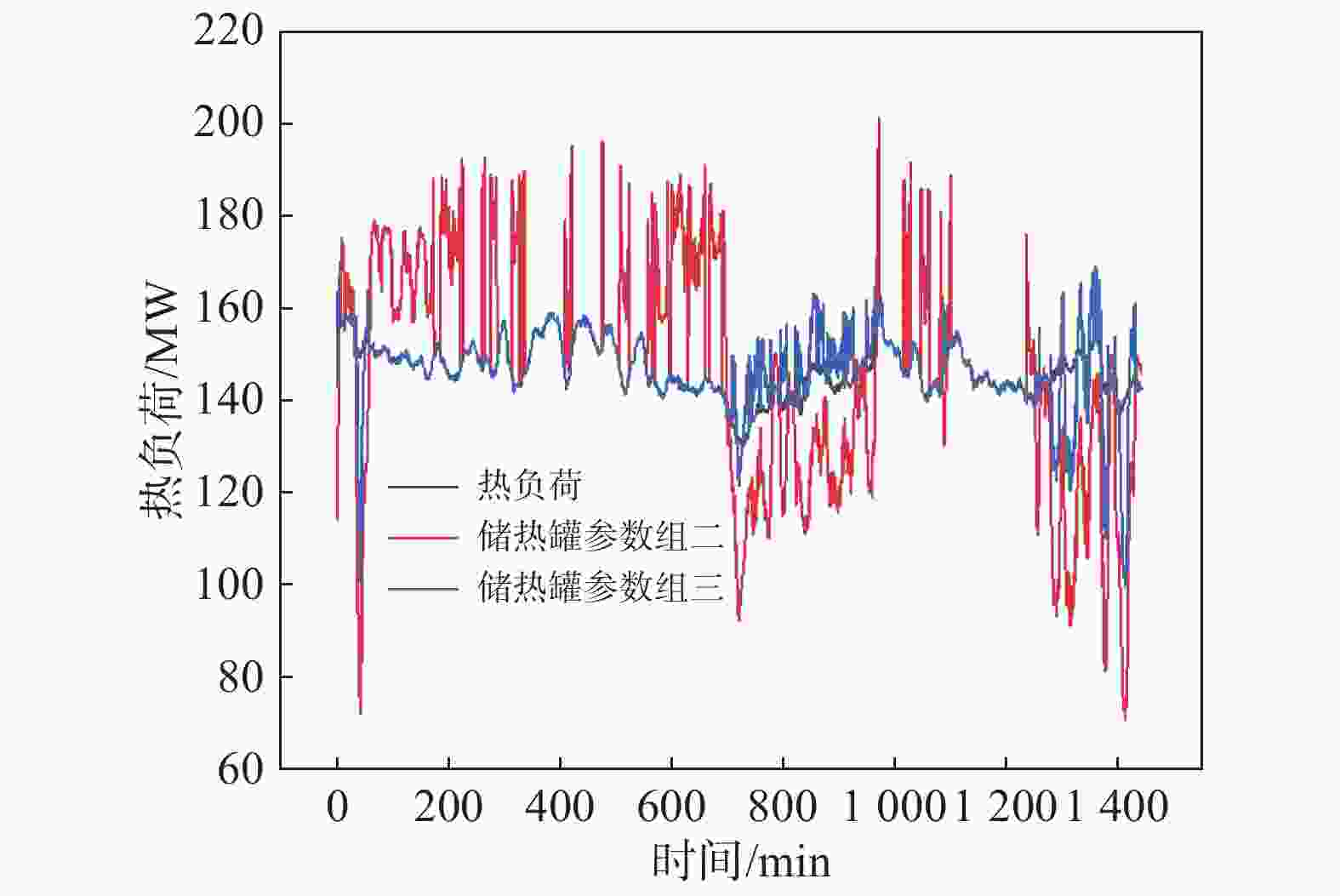
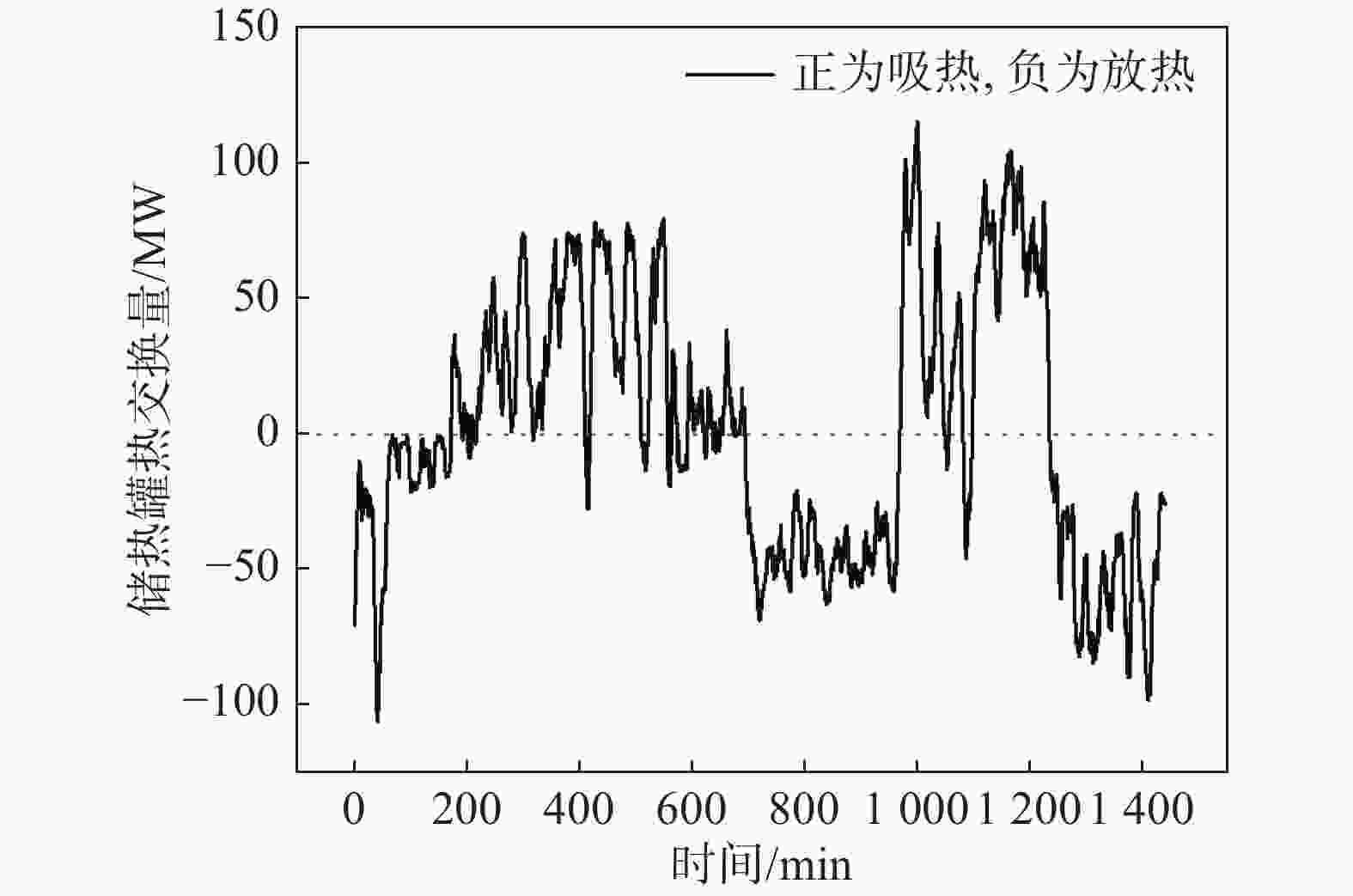
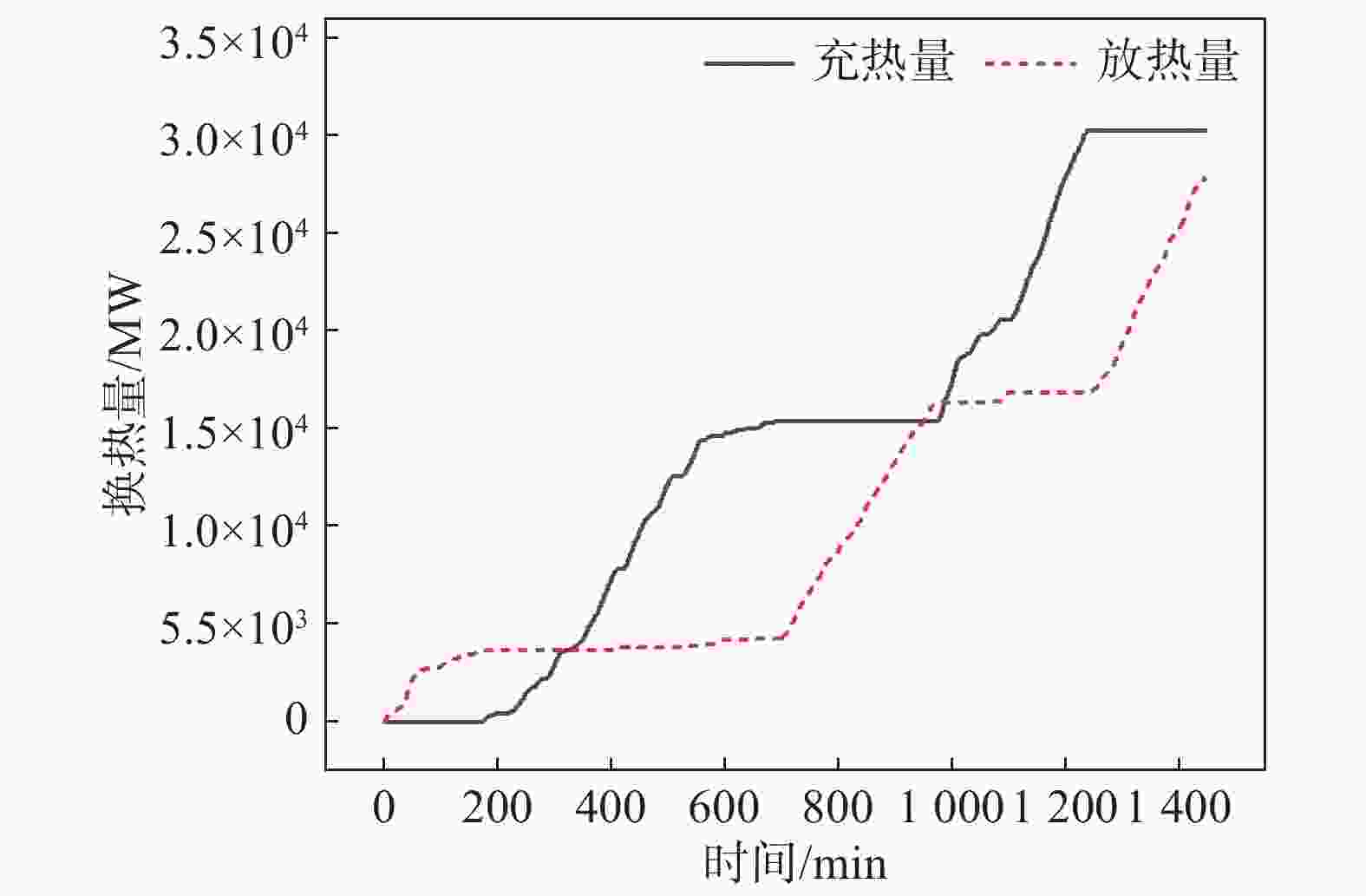

 DownLoad:
DownLoad:
